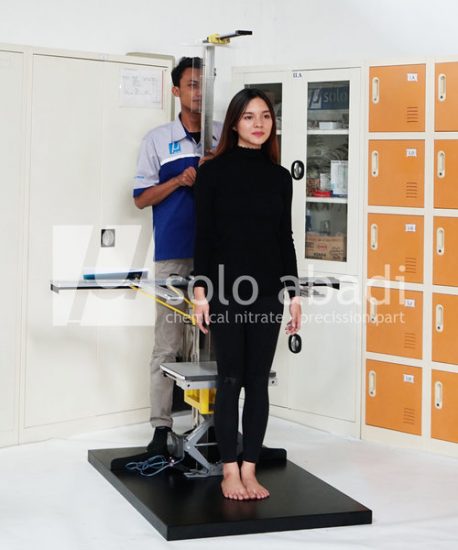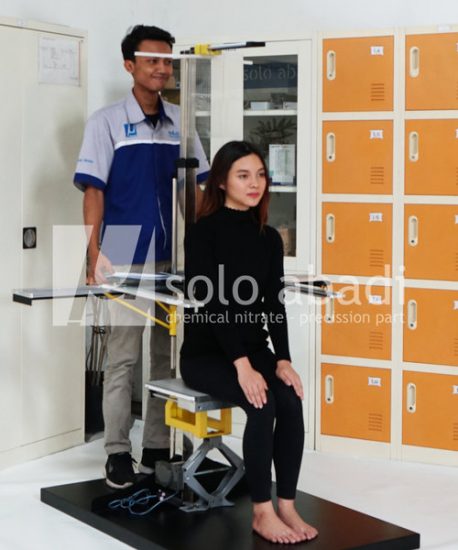As we all know, the application of anthropometry is very important in order to increase the comfort of a product for the user. And the anthropometry chair itself is useful as a consideration for a tool to measure the dimensions of the human body so that products designed are more suitable and comfortable.In measuring human body dimensions using anthropometric chair there are various factors that influence the differences in data results. With a variety of variability, the size of the human body dimensions needs to be considered when calculating. Factors that affect data differences are:
1. Gender
Judging from gender, of course we all agree if generally men have a larger body dimension than women.
2. Age
The size of the human body will develop from birth to 17 years. And finally it will decline when it is 60 years old.
3. Ethnicity (Ethnicity)
By being influenced by the geographical location where humans live, dimensional variations will occur.
4. Work
With the intensity of daily work also causes differences in the size of the human body.
Then how do you do anthropometric measurements?
Judging from how to do calculations, anthropometry itself is divided into two body measurement techniques, namely:
1.Static Anthropometry Measurement
This method is done by means of body dimensions measured by measuring the state and physical characteristics of humans in a state of silence. Another term for body measurements is known as “static anthropometry”. Dimensions measured include weight, height in standing and sitting, head size, knee length when standing and sitting, and arm length.
2. Dynamic Anthropometry Measurement
Dynamic calculations are related to the measurement of conditions and physical characteristics of humans in a state of movement or attention to movements that might occur while doing a job.
In practice, there are dynamic measurement divisions namely skill level measurements, room range measurements when working, and work variability measurements.
Data that can be measured by anthropometric chairs
With the chair of anthropometry, we can obtain some measurement data on the dimensions of the human body. Broadly speaking, the anthropometric chair has measurement guidelines including:
1. STANDING POSITION MEASUREMENT

Measurement of the dimensions of the human body using the chair of anthropometry with the attitude of the subject standing upright, by adjusting several movements to take the calculation. The details of the movements in the standing attitude include:
- Height of the body, measuring the vertical distance from the floor to the top of the head.
- Height of the eye, measuring the vertical distance from the floor to the tip of the inner eye (near the base of the nose).
- Shoulder height, measuring the vertical distance from the floor to the prominent shoulder on the side of the shoulder.
- Elbow height, measuring the vertical distance from the floor to the meeting point between the upper arm and forearm (elbow).
- High Fingertip, measure the dimensions of the size between the floor to the tip of the finger with a straight up and down hand.
- Bone height, calculation with the subject standing upright and calculated from the side between the soles of the feet to the base of the fingers with the hands straight down.
- Hip height, measuring the hip height of the subject by the way the subject stands and is measured from the sole of the foot to the hip point.
- Hand held height, measuring the distance from the floor to the outermost point of the hand when holding position. With the attitude of the hand perpendicular to the top.
- Wrist height, measuring the distance from the floor to the wrist point. With a straight hand up and down.
- High Range of Hands, measurements from the floor to the outermost fingertips. With a standing attitude and hands raised up as high as possible.
- Waist height, measuring between the floor and waist side. Where the waist is located between the abdomen and the back of the chest.
- Wide Hip Stand, calculating the dimensions of the distance from the right hip to the left side.
- Elbow Length to Wrist, measuring the outermost side of the subject’s elbow, to the wrist.
2. SITTING POSITION MEASUREMENT

- High Popliteal Sit, measuring the vertical distance from the floor to the bottom of the thigh.
- Head width, measuring the width of the head by the way the subject looks forward and counts the head of the right side to the left side.
- Upper Shoulder Width, measures the horizontal distance between the two upper arms and the subject sits upright with the upper arm close to the body.
- Sitting Shoulder Width, measurement with the subject sitting upright and measured from the outermost side of the right side to the left side.
- Wide Hip sitting, how to calculate that is with the subject sitting upright and measured horizontally from the hip to the left side to the right side.
- Hand held length, calculates the distance between the back points attached to the back to the point of the fist. With the position of the hand pointing straight ahead.
- Elbow Stretching Length, measuring the range of the outer side of both sides of the elbow. By the way the subject sits and stretches both elbows horizontally right and left.
- Hand Extend Length, how to measure between horizontal distances from the tip of the left hand to the tip of the right finger. The subject horizontally stretches both hands to the side.
- Handheld Height up Sitting, measuring between the seat base of the subject and the point of your hand. With the position of the hand pointing up.
- Upright Sitting Height, measuring the vertical distance from the surface of the subject’s seat to the top of the head.
- Sitting Eye Height, measuring the vertical distance from the seat to the end of the inner eye.
- Sitting Shoulder Height, measuring the vertical distance from the seat surface to the tip of the outer shoulder bone.
- Sit Elbow Height, measuring the vertical distance from the seat to the lower end of the elbow. With the position of the upper arm straight down and the lower hand bent forward.
- Shoulder Length to Elbow, measuring length from the outer side of the shoulder to the limit of the subject’s elbow. With the position of the upper arm straight down and the forearm bent forward.
- Sit Thigh Thickness, measures the distance from the surface of the subject’s seat to the surface of the subject’s thigh.
- Long forearm seated, measuring the distance between the elbows to the tip of the outer finger. With the position of the upper arm straight down and the forearm bent forward.
- Sigh Thigh Length, used to measure between the pelvises to the inside of the knee. With the position of the foot the subject sits forward.
3. FACE AREA MEASUREMENT

- Head Length, measures the distance between the subject’s head and the outermost back to the outermost size of the front, usually the tip of the nose.
- Head height, measuring the distance between the bottom of the chin and the upper limit of the subject’s head.
- Chin’s eye height, the calculation between the lower chin and the inner eye.
- Eye to Eye Width, measurement between the centers point of the left eye and the midpoint of the right eye.
So when measuring human dimension data, the detail that becomes the main focus will be fulfilled. With this anthropometric chair design, it is hoped that the measurements taken will increase the value of the products you make.


